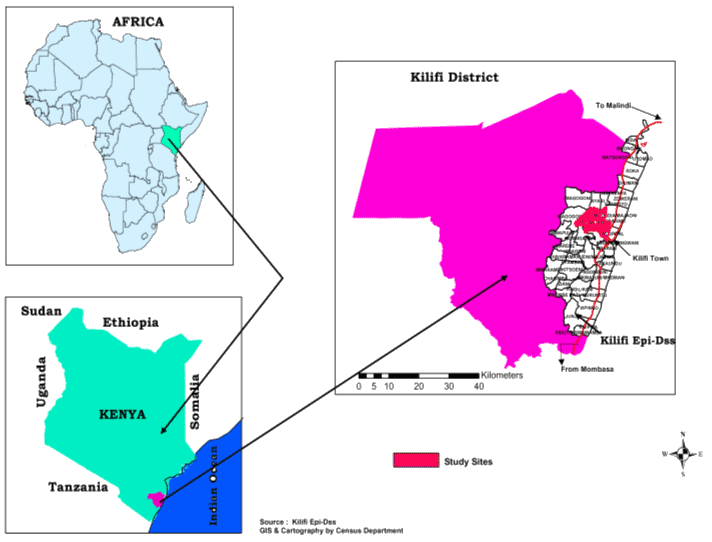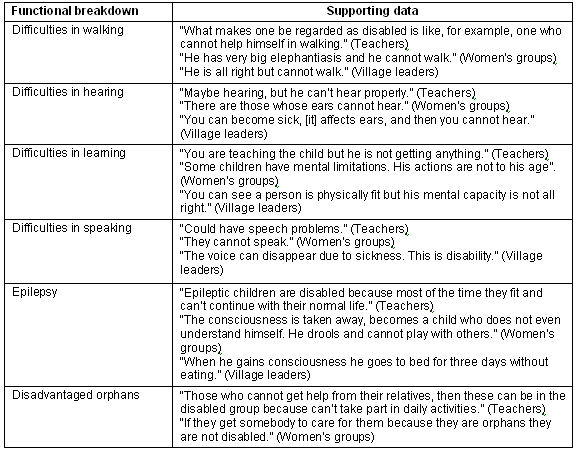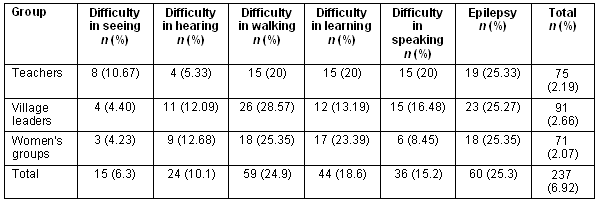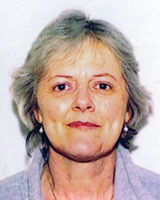Introduction
Around the world for many decades surveys have been used as a means of collecting data for government planning, but it is only relatively recently that surveys have been used to collect data on disability1. For example, the National Health Interview Survey (NHIS) has been a standard measure for assessing health in the USA, but it was not until 1994/1995 that the disability supplement was added2. At this point, policy makers and program operators felt they could access strategies to improve the quality of life of persons with disabilities and felt the need to know more about the demographics of this population in order to plan effectively. The National Health Interview Survey for Disabilities (NHIS-D) is, therefore, designed to determine the prevalence of disabilities for policy planning3. This survey seeks to determine the number of persons with disabilities (PWD) entitled to Social Security Disability Income (SSDI), or Supplementary Security Income (SSI)4. These survey techniques are more easily applicable to impairment component of disability, but cannot easily encapsulate the social determinants of disability. The survey method is even more problematic in resource-poor countries because of different cultural perceptions of disability, survey structures and cut-off levels. These additional factors also contribute to the perceptions and interpretation of disability, for example some cultures in Kenya consider a person who is not able to look after cattle is disabled5. In addition, administrative data and registries may be useful sources of population-based information in resource-replete countries, but these are rarely available in resource-poor countries6.
In resource-poor countries, census surveys have been used to identify children with disabilities. House-to-house surveys have also been widely used in the identification of children with impairments7. However, these survey methods have been time consuming and expensive and invariably they have not resulted in better services8. In resource-poor countries they deflect resources from supporting people with disabilities and their families9. They are reported to be wasteful or counter-productive when they are not followed by increased services for those identified10.
An alternative strategy for the identification of disabled people which involves community participation and has the potential for more effective sustainability lies with the participatory appraisal process. Participatory rural appraisal (PRA) evolved as a research approach from agricultural surveys. It involves local communities as active analysts of their own situation so the communities can set their own priorities on how to change their situations11. This empowers people, giving them a sense of ownership.
Eyler et al. has suggested that PRA is an important tool for planning and evaluating community health programs12. Information from key informants is useful in identifying support in service delivery, and gaining access to potential influences for community change. According to Pretty, PRA is a defined methodology and systematic learning process13. It stresses changes in the behavior and attitudes of outsiders to become facilitators, not lecturers, but listeners and learners. Furthermore, Pretty portrays PRA as group process learning13. It involves the recognition that the complexity of the world will only be revealed through group inquiry interaction.
The methodology is concerned with the transformation of existing activities in an attempt to bring changes that people in the situation regard as improvements13. The role of the expert is to help people achieve what they want, regardless of their social or financial situations. It leads to debate about change and the debate changes the perceptions of the actors and their readiness to contemplate action. The agreed action and the changes represent an agreement among conflicting views13. In particular, agreement on particular issues in the identification of disabilities portrays the accommodation of conflicting opinions.
The ultimate goal for the identification of people/children with disabilities should be improved service delivery for them14. The PRA approach offers the possibility of a more sustainable option. In a standard survey, the community is rarely consulted or involved in the identification process8. The lack of community involvement may also adversely affect the implementation of disability services15.
Additionally, several studies have shown that participation by local people is one of the critical components of success in development projects in the community16-18. Without this participation, projects geared to benefit the community can be rendered useless. PRA is, therefore, a methodology that not only generates information to inform outsiders, but also facilitates local people to analyze their own situations19.
Perceptions of disability
Helander sees social perceptions of disabilities arising as a result of the cultural beliefs and practices which exist in communities20. Ingstad illustrates this and argues that some societies perceive disability as an incurable illness21.
According to Groce, cultural beliefs about disabilities are strongly influenced by religion, socio-economic status and educational background22. These beliefs affect how PWDs are treated in each culture. In a study looking at the existing practices underlying attitudes towards children with epilepsy in Kilifi, Kenya23, it was found that cultural beliefs and perceptions towards persons with epilepsy affected treatment and social acceptance.
Epstein argues that PWDs' feelings about their disability were found to reflect their parents' attitudes towards them24. Parents' attitudes towards their disabled children could influence the attitudes of other people in the community and, consequently, this could influence identification of disabilities by those people in the community25. Negative social attitudes to impairments can act against effective community participation26.
Groce, cited by Higgins, further argues that people with disabilities are far more limited by the society's view of disability than their actual disability27. Therefore, determining how people in the community perceive disability could be a possible indicator in reflecting how the participatory method of identifying disability would be influenced28.
This study aims to investigate the use of PRA by the local community to identify children with disabilities in a rural situation in Kenya. The process of identification of children with disabilities is compared with that of an epidemiological survey.
Methods
The study used a qualitative research process because it provided the means of accessing local perceptions of disability and promoted the participation of people in the community. It employed a systematic design to explore the phenomenon of the Mijikenda perceptions of disability, and then used the same design to identify those disabilities. The Mijikenda are the indigenous people of the Kenyan coast; these comprise nine tribes who share a common language (KiGiryama). Focus group discussions were used to explore the perceptions of disability. Social mapping was conducted to identify children with disabilities. The study addressed one research question: can PRA be used in the identification of children with disabilities?
Study population and site
A purposive convenience sample of 144 people was identified from three community groups: village leaders, women's groups, and teachers. All resided in the Kibarani and Konjora sub-locations in Kilifi, on the coast of Kenya (Fig 1). The two sub-locations were chosen due to their proximity to the research unit. Village leaders were selected due to their being conversant and well informed in community issues. Women's groups were thought to have valuable experience and understanding of children in the community. Teachers were regarded as the most knowledgeable and trusted group of people in the community. Hence, people often confided in them and asked for their advice on different aspects of life.

Figure 1: Maps of the study site in Kenya.
Data collection
Two methods of data collection were utilized: focus group discussions and social mapping. Twelve focus group discussions were conducted to explore how disability was perceived within the Mijikenda context. Each focus group discussion had 12 participants. Focus group discussions were conducted through a moderator who was from the same ethnic group and was fluent in KiGiryama. All discussions were tape-recorded and conducted in KiGiryama. Participants were encouraged to talk freely, and to discuss issues concerning children with disabilities among themselves in order to bring out social dynamics. Open-ended questions based on previous work on disability in the area were used to guide the discussions. In addition, 12 social mapping activities were performed according to established procedures, as described by Shyma8. Participants selected symbols for the different disabilities they had identified (eg a leaf for disabilities in hearing, a small stone for those in walking), the area was mapped and the symbols placed appropriately within the community the disabilities identified. This method made it possible even for the illiterate to take part actively.
Village leaders are chosen by the community to help the sub-chief in the administration of the sub-location, which is an administratively defined area. Typically, a sub-location is made of at least 12 villages. Kibarani was the only sub-location with a woman as village leader.
Teachers were invited from all primary schools in the study site. There were equal numbers of male and female teachers. Women's groups are formed on an economic basis to enhance quality of life through dairy and poultry farming, buying seeds in bulk etc, and are registered with social services.
Identification of households was performed to make sure children were not identified more than once in every sub-location.
Table 1 gives a summary of the number of activities of participants in both focus group discussions and social mapping.
Table 1: Summary of the activities involving different participants in each sub-location

Data analysis
Focus group discussions were recorded, transcribed and then translated. The set of transcripts were reviewed to identify the main themes; the data were coded according to a particular theme and categorized accordingly. Ideas and patterns were then inferred from the participants' specific responses. The researcher responsible for the data collection carried out the manual analysis. The focus group discussions transcript notes were read and cross-checked by co-researchers. The recording equipment used for the focus group discussions was checked regularly to determine its reliability.
Results
The perceptions of disability were presented from the viewpoints of the different groups that participated in the study. Analysis of the data revealed that all three groups of key informants had similar views as to what constituted a disability, with one exception. The teachers and the women's groups considered disadvantaged orphans as disabled, and village leaders did not.
Table 2 provides a summary of the different perceptions of disability, as given by the groups. They appeared to describe disability mainly at the level of functional breakdown rather than by related causes.
Table 2: Perceptions of disability categorized into different domains

Most of the local perceptions of the causes of the disabilities came from the village leaders' focus group discussions outlined (Table 3). Much disability was attributed to evil spirits or witchcraft ('spells' cast on others).
Table 3: Traditional beliefs about the cause of disability, as stated by village leaders

Identified children with disabilities
In total 237 children aged between 9 and 15 years with disabilities were identified in both Kibarani and Konjora sub-locations. The two sub-locations had a total of 3427 children aged between 9 and 15 years. A disability prevalence rate of 69/1000 was established. There were only two cases of children identified by two groups. This was possible because the groups interviewed did not dwell in close proximity. A lottery method was used to select one group to have identified the children. Table 4 gives the details of children identified in the two sub-locations.
Table 4: Identified children in Kibarani and Konjora sub-locations

Identified disadvantaged orphans in Kibarani and Konjora sub-locations
The total number of disadvantaged orphans identified in the two sub-locations was 51. This was 1.49% of the total number of children in the two sub-locations aged between 9 and 15 years. Women groups identified 41 children, which was 80.39% of the disadvantaged orphans, while teachers identified 10 children, which was 19.61%. Village leaders did not identify any disadvantaged orphans.
Discussion
The study shows that PRA can be used to identify children with disabilities; however, the children identified are dependant of the group involved in the PRA. There were considerable discrepancies between the children identified with disabilities by each of these groups, despite the fact that the three groups of key informants used in the study had similar perceptions of disability.
Perceptions of disability were from the activity and participation levels. All groups perceived disability from the existence of impairments, as well as restrictiveness in activity and participation limitation. This is in accordance with the International Classifications of Disability and Functioning (ICF)29. This reflects the community's perception of disability from a holistic perspective. There was one notable exception: the orphans, in whom the identification of disadvantaged children was different between the village leaders and other groups. In this community, orphaned children are traditionally cared for by relatives and neighbours, but there is a growing number of children for whom this is not occurring and, thus, they are significantly disadvantaged as perceived by the teachers and the women's groups. This evidence suggests that the issue of disadvantaged orphans is a matter of concern to the women, perhaps because they have greater insight into the problems of the disadvantaged. Further, it can be suggested from the evidence that women are more concerned about disadvantaged orphans than are men.
It was not clear why women's groups and teachers thought this group of children was disabled. However this could possibly reflect the prevalence of HIV/AIDS in the community. Such children may be HIV infected, malnourished and lack emotional support. As a result, the social welfare of these children is disrupted and their normal lives are affected. This group was treated as a separate and not included in the main categories because there was disagreement about them among three study groups.
However, the fact that two groups perceived disadvantaged orphans to be disabled is a significant finding. It emphasizes the social determinants of disability as a large part of the perceptions of the disablement package, and underlines how an impairment focus excludes key determinants of disablement.
Although this is not an epidemiological study, these results revealed an overall prevalence disability rate of 69/1000 excluding disadvantaged orphans, which is similar to a prevalence rate of a study performed in India (67/1000) using the same approach8. This rate is also similar to that found in a survey of neurological impairment in children aged between 6 and 9 years, conducted 3 years previously in Kilifi7. However, the two studies may have identified different children and could not be compared because they were performed at different times. An advantage of PRA is the quality of information obtained, cohesiveness, and the ability to achieve consensus. Similar dynamics were reflected in Shyma's study8.
The time span of the PRA study was 2 months. It could be argued that this approach is a fast and therefore inexpensive method of screening disabilities in rural areas in resource-poor countries. The rapid nature of PRA was also highlighted in Shyma's study8. The number of people involved and the length of time taken in the house-to-house survey indicates a considerably greater cost. The Kilifi and Bengal house-to-house survey indicated each child identified cost approximately US$7 and $14 respectively. The Kilifi PRA approach spent approximately $7 for both focus group discussion and social mapping activity per session. This was approximately equivalent to the identification of every child costing $1.20. Thus, PRA is inexpensive to carry out in the community. Shyma also sighted the cost-effectiveness of PRA in his comparative study of rapid rural appraisal and a house-to-house survey method8.
The PRA process did serve to provide an educational intervention that raised people's awareness, not only to the existence of disabled persons, but also to their own possible role in the lives of those people.
Conclusion
The PRA identifies children with disabilities according to local perceptions. It is a cheap and fast method of screening for disabilities in a rural setting with limited facilities. It also allows local perceptions of disability to be taken into consideration, and facilitates local participation which may have a positive effect on future community involvement in disability rehabilitation programs.
Acknowledgements
The authors would like to thank the Director of Kenya Medical Research Institute (KEMRI) for permission to publish the data. Grateful thanks are also extended to Gladys Murira, Kenneth Rimba, and Judy Tumaini for reading through the transcripts to generate themes that contributed to the rigour of the analysis. We also thank Mary Karisa for translating and transcribing the focus group discussions. Thanks to the social workers of Kilifi county council for helping in the identification of the active women's groups. This work would not have been possible without the participation and involvement of teachers, village leaders and women's groups from Kibarani and Konjora sub-locations. We also thank Greg Fegan for his statistical advice. Last but not least, we would very much like to thank KEMRI/Wellcome Trust Kilifi research program for their financial support for this study.
References
1. Hendershot G, Larson S, Lakin C. An overview of the National Health Interview Survey on Disability. B Atlman, S Barnartt, G Hendreshot, S Larson (Eds). Using survey data to study disability. Oxford: Elsevier, 2003.
2. Fedeyko H, Lollar D. Classifying Disability Data. B Atlman, S Barnartt, G Hendreshot, S Larson (Eds). Using survey data to study disability. Oxford: Elsevier, 2003.
3. Altman B. Operational definitions of disability using the NHIS-D. B Atlman, S Barnartt, G Hendreshot, S Larson (Eds). Using survey data to study disability. Oxford: Elsevier, 2003.
4. Brandt B, Pope A. Enabling America: assessing disability and rehabilitation. Washington DC: National Academy, 1997.
5. Helander E. Prejudice and dignity: an introduction to CBR. New York: UNDP, 1999.
6. Durkin M, Davidson L, Desai P. Validity of the ten questions screen for childhood disability: results from population based studies in Bangladesh, Jamaica and Pakistan. Journal of Epidemiology 1994; 5: 283-289.
7. Mung'ala-Odera V, Meehan R, Njuguna P, Mturi N, Alcock K, Carter J et al. Validity and Reliability of Ten Questions Questionnaire for detecting moderate to severe neurological impairments in children aged 6-9 years in rural Kenya. Journal of Neuroepidemiology 2004; 23: 67-72.
8. Shyma K, Abraham J. Identifying disability: comparing house-to-house survey and rapid rural appraisal. Health Policy and Planning 1999; 14: 182-190.
9. Sshneider M, Loeb M, Mirembe J, Asindua S, Dube S, Hartley S. Collecting Disability Statistics: A Participatory Strategy? S Hartley (Ed.). CBR a participatory strategy in Africa. London: University College London, Centre for International Child Health, 2002.
10. Saunders C, Miles S. The uses and abuses of surveys in service development Planning for disabled people: the case of Lesotho. London: Save the Children UK, 1990.
11. Townsley P. Rapid rural appraisal, Participatory rural appraisal and aquaculture. Rome: FAO, 1996.
12. Eyler A, Mayer J, Rafii R, Housemann R, Brownson R, King A. Key informants surveys as a tool to implement and evaluate physical activity interventions in the community. Health Education Research 1999; 14: 289-298.
13. Pretty J. Alternative systems of inquiry for sustainable agriculture. IDS Bulletin 1994; 25: 37-38.
14. Miles S. Engaging with disability rights movement: The experience of CBR in Southern Africa. Disability and Society 1996; 1: 501-517.
15. Uzochuku B, Akpala C, Onwujekwe O. How do health workers and community members perceive and practice community participation in the Bamako Initiative programme in Nigeria? A case study of Oji River local government area. Social Science and Medicine 2004; 59: 157-162.
16. USAID. Women in development: A.I.A. experience, 1977-1985. AID Programme Evaluation Report no. 18. Washington DC: USAID, 1987.
17. World Bank. The World Bank and participation: Report of the learning group on participatory development. Washington DC: World Bank, 1994.
18. Pretty J. Regenerating agriculture: policies and practices for sustainability and self-reliance. London: Earthscan Publishers, 1995.
19. Chambers R. Challenging the professions: frontiers for rural development. London: Intermediate Technology Publications, 1993.
20. Helander B. Disability as incurable illness: health, process and personhood in Southern Somalia. B Ingstad, S Whyte (Eds). Disability and Culture. London: University of California Press, 1995.
21. Ingstad B. Coping behaviours of disabled persons and their families: cross-cultural perspective from Botswana and Norway. International Journal of Rehabilitation Research 1998; 11: 351-359.
22. Groce M. Disability in cross-cultural perspective: rethinking disability. The Lancet 1998; 354: 756-757.
23. El Sharkawy G. Existing Practices and underlying attitudes towards children with epilepsy in Kilifi, Kenya. M.Sc thesis. London: Institute of Child Health, University College London, 2002.
24. Epstein S. We can make it: stories of women in developing countries. Geneva: International Labour Organisation, 1997.
25. Barquer A, Sharma A. Disability: challenges and responses. New Delhi: Concerned Action Now, 1997.
26. Coleridge P. Disability, liberation and development. Oxford: Oxfam, 1993.
27. Higgins C. Disability in a cross-cultural perspective: Rethinking disability. World Disability 2002; 12: 19.
28. Zanetell B, Knuth B. Participation rhetoric or community-based management reality? Influences on willingness to participate in a Venezuelan fresh water fishery. World Development 2004; 32: 793-807.
29. WHO. International classification of disability and function. Geneva: World Health Organization, 2001.


